How to Create an AI App: Full Overview
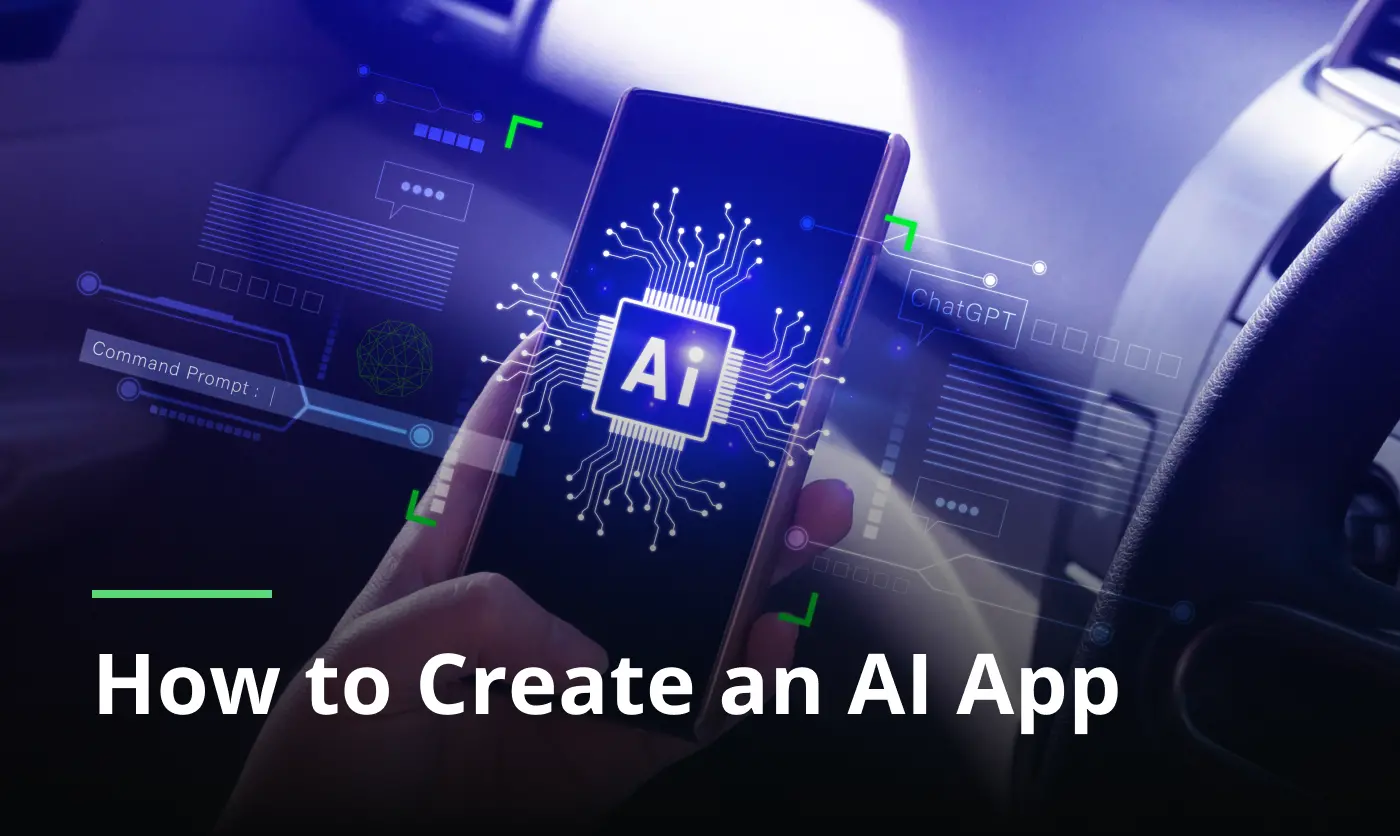
AI app development has stepped off the movie screen and into your phone, forcing businesses to work smarter and faster. Our summary will unpack the transition from raw idea to polished application, how these tools are built, grown and adjusted for maximum output. Founders chasing a vision or product owners eyeing the next big leap will uncover insights worth their weight in gold.
You’re amidst many who are eager to build an AI app. The road isn’t as winding as it seems but it does call for sharp thinking and stuff that makes it click. From defining your use case to training your models and integrating APIs, every decision can make or break the outcome. We’ve turned ten years of trial-and-error into a shortcut you may use.
In cut-throat artificial intelligence application development the ground never stops moving — pause too long and you’re outpaced. Back a company with know-how and your product might just flip the script. That’s why it pays to partner with seasoned pros like Limeup, as we know the ropes and bring fresh AI solutions to the table. So roll up your sleeves, we’ll cover what top-tier АІ app really is, how to build one and all the moving parts under the hood.
What is an AI application?
At its core, this kind of software thinks a bit like we do, only quicker and without the need for coffee. Information is reviewed to detect patterns and make quick decisions. IBM puts it simply: these systems mimic how people solve problems and make choices.
But let’s not race ahead. AI in app development shows up in many forms, from voice assistants that finish your sentences to movie platforms that know what you’ll enjoy next. They help banks catch fraud in real time and assist doctors in detecting health issues before symptoms even appear. There’s no magic here, just clever engineering.

What makes custom application development with AI special is its ability to learn from experience. Instead of following a rigid script, it improves every time someone uses it. That’s why so many companies are turning to this approach to personalize services, cut through complexity and stay one step ahead of the competition.
With smart tech on every roadmap, AI app developers are finally getting their close-up. They’re the navigators in this high-speed environment, turning ambitious ideas into practical, smart applications with speed and structure. Clarity, strategy and precision are their calling cards.
When people talk about this type of tech, they mean systems that learn on the fly, level up through use and constantly fine-tune their skills. In a digital world that doesn’t slow down, that kind of cleverness is worth its weight in platinum.
Types of AI applications
No capes, but plenty of superpowers — that is the promise of AI application development. Some apps converse like tried-and-true agents, others sift through oceans of data to predict what’s next. Every version brings its own brand of smart to the problem at hand.
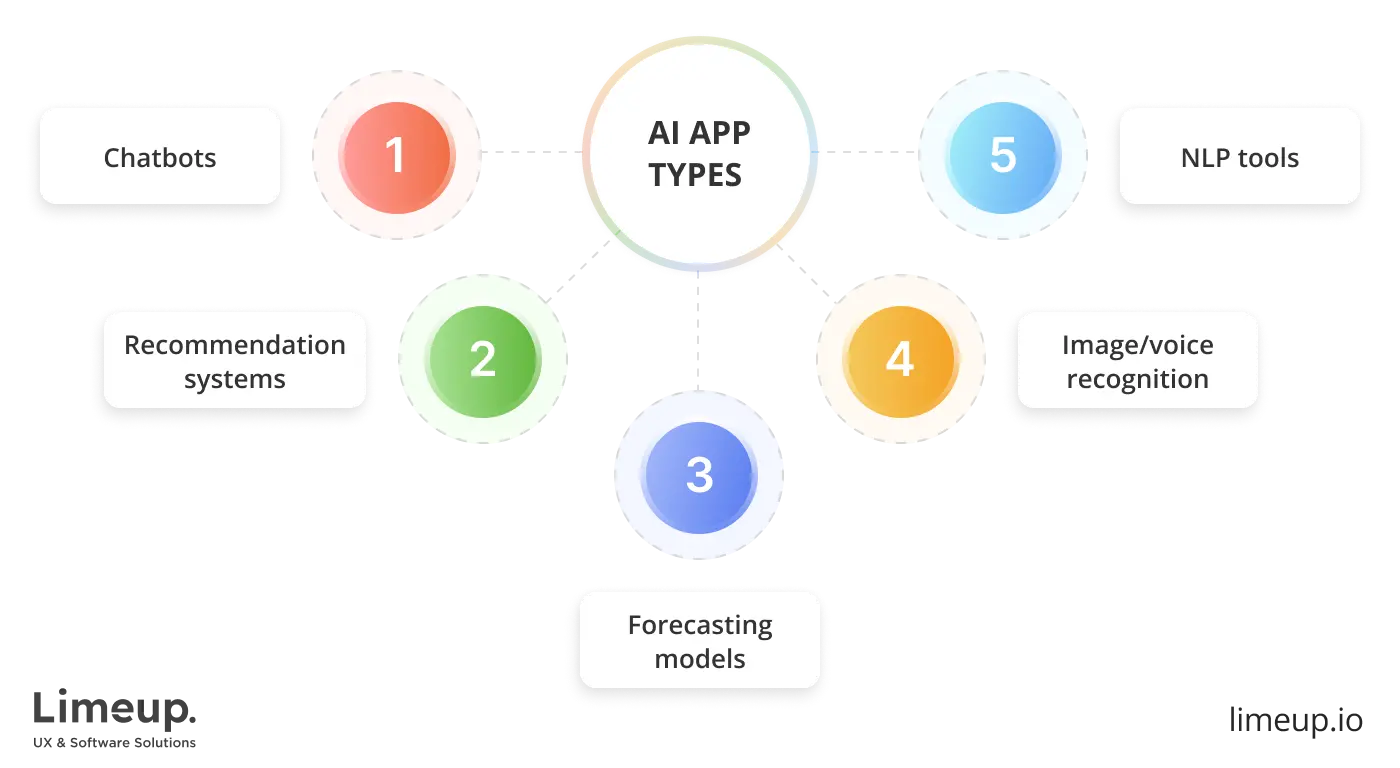
Chatbots. Forget scripted, robotic replies. Modern AI-powered chatbots understand intent, pick up on nuance, and keep the conversation flowing. From answering banking questions at 2 a.m. to helping users book travel without breaking a sweat, these bots are frontline heroes in customer service.
Recommendation systems. Ever wondered how your music app serves up the perfect playlist or how online stores seem to know your style better than your friends do? That’s recommendation AI at work, constantly crunching preferences, browsing habits, and subtle cues to curate suggestions that hit the mark.
Forecasting models. AI wears its fortune-teller hat in this space, analyzing trends and behaviors to predict the future, identify risks, and empower businesses to act with foresight.
Image/voice recognition. AI applications in this lane see and hear the world and then make sense of it. Authentication becomes faster through the additional security feature which uses facial recognition. Voice assistants automate everyday tasks which consist of device unlocking and writing messages and maintaining digital memoranda like an unending digital assistant.
NLP tools. They aren’t just about fixing typos. Such instruments understand context, extract valuable information from documents, translate across languages, and summarize complex material in seconds. It’s like teaching your software to think like a linguist.
How to build an AI app: 5-step explanation
Making an AI app doesn’t require a lab coat and a PhD in astrophysics, but it definitely calls for more than guesswork. Creativity, strategy, plenty of fine-tuning go into the mix. Such software needs a brain, a clear purpose and the capacity to learn on the fly.
The global AI software market is set to top $1.01tn by 2031, a clear signal that AI is no longer a side act but a center stage. So, how do you turn a bold idea into something smart enough to grow and adapt? Forget the buzz, here’s how it really works, one smart step at a time.
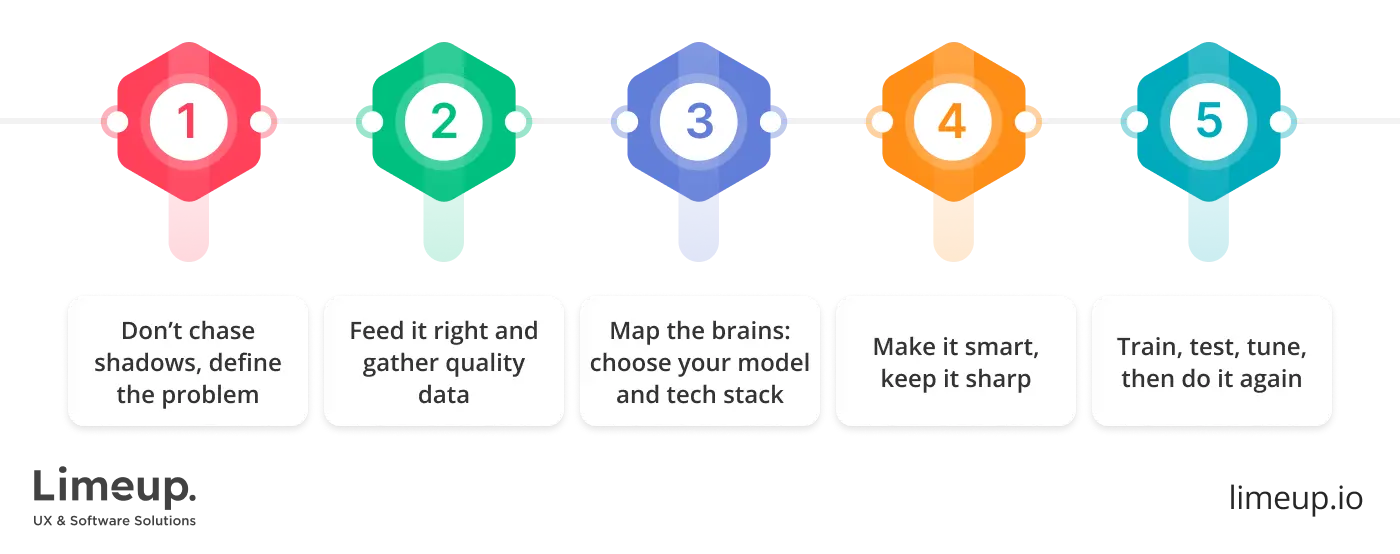
Step 1: Don’t chase shadows, define the problem
Before diving into code or model selection or any other technical side of how to make an AI app, get your bearings. What problem are you solving and who’s feeling the pain? Vague goals like “make it smarter” or “add AI” won’t cut the mustard. Define a real, tangible challenge your users face. The clearer the target, the sharper the solution. Skip this and you’ll be throwing darts in the dark.
Step 2: Feed it right and gather quality data
Data forms the core of any application. If it’s messy or lacking, the results won’t measure up. Accuracy and variety should be at the forefront when sourcing datasets, no matter if you’re using internal archives or tapping external resources. Expecting perfect outcomes from raw data is simply wishful thinking.
Step 3: Map the brains: choose your model and tech stack
This is where the rubber meets the road. Think strategy: classification, prediction, NLP or recommendation engines, each calls for a distinct modeling approach in AI mobile app development. Pick a stack that supports scalability and experimentation. TensorFlow, PyTorch, AWS, Azure are all heavy hitters, but don’t just follow the herd. Match tools to needs, not hype.
Step 4: Make it smart, keep it sharp
AI may handle the thinking, but humans still judge the look. A clunky interface will trip up even the smartest system. That’s why you need to hire app design experts who understand both UX and the quirks of AI interaction. The goal will be to design an app that flows effortlessly, with the user’s needs always at the heart of the process.
Step 5: Train, test, tune, then do it again
Once your app is built, it’s time to hit the training loop. Don’t expect perfection from AI app development services providers on day one, AI is more of a marathon than a sprint. Train the model, test its accuracy, monitor performance and adjust accordingly. Real-world audiences will stress-test your app in ways a dev team never could. So keep your ear to the ground and don’t be afraid to go back to the drawing board when needed.
What are the key features in AI app development?
Without proper core functionality your app remains invisible even when you have the most attractive UI since it needs both cognitive skills and adaptability in delivering value to keep people engaged. Great AI apps seem effortless to customers despite running in the background on advanced instrumentations. Five key elements make genuine competitors differ from other digital actors in the market.

Smarter data flows. Every smart application contains large volumes of data that form its central core. The essence of raw data does not provide sufficient value for business operations. AI applications depend on processing power to handle vast amounts of data while refining it through proper cleaning storing and organization without any disruption.
Understanding how to build AI apps requires integrating strong data pathway systems, synchronized processing and self-operated inspection devices at every moment. No fluff. Just data you can bet on.
Live reactions. The competence to operate without delays has shifted from luxury status into an absolute necessity. Today’s application consumers need instant reaction times from their software since it helps identify criminal activities and recommends appropriate products. Businesses need to bring on board machine learning models that operate without sleeping at their posts.
When your application reacts quickly it becomes more beneficial for customers and they recognize that enhanced quality. Your system functions like an awake and smart mind enriched with energizing caffeine.
Just-right suggestions. Artificial Intelligence brings its genuine power to display through specific features such as playlists or personalized content serving. The boundary between appropriate assistance and unwanted intrusiveness remains thin. Modern ethics in AI application development and clear information regarding data processing systems are essential components for achieving ethical success.
Exceptional apps understand how to determine boundaries which results in an experience that emulates personal human interaction. Research by Deloitte establishes that 80% of customers tend to spend more time with brands that implement personalization in their services.
Decoding decisions. Gone are the days of the black-box excuse. Consumers, regulators, businesses want to know why an AI made a decision. Enter explainable AI (XAI), a feature that lays things bare in plain language. Whether it’s an insurance app denying a claim or a chatbot giving odd advice, users appreciate clarity. It builds trust. And trust is gold.
Plug in and go. Another moment to remember is that if you have started app development with AI that such apps don’t exist in a vacuum. They have to play well with your current tech stack: databases, APIs, third-party resources, you name it. The smoother the handoff, the less friction for your team and your audience. It holds special weight for firms scaling fast while anchored to systems that aren’t easy to swap out.
Anticipatory Intelligence. One of the most compelling attributes of AI is its ability to predict future events based on past data. Some tools follow instructions. Others pick up on what’s ahead. Apps powered with foresight are able to flag issues in supply chains and anticipate customer needs, turning preparation into a built-in advantage. Being ready becomes part of the system, not just a lucky break.
Curious about how to develop an AI app or any other software using the power of crew from Great Britain? You may check our material about application development companies in the UK, their comparison and questions to ask before hiring them.
What tech stack is used to create an AI app?
If creation of an AI app were a road trip, your tech stack would be the car. Pick the right ride and you’ll cruise through programming. Choose poorly and you’re pushing a broken-down van uphill. Behind every slick AI product is a solid stack — utilities and frameworks working together like a pit crew to keep the engine humming.
The beauty of it? Forget about filling a warehouse with utilities, just concentrate on having the harmonious ones working in unison. An overview of the essentials follows.
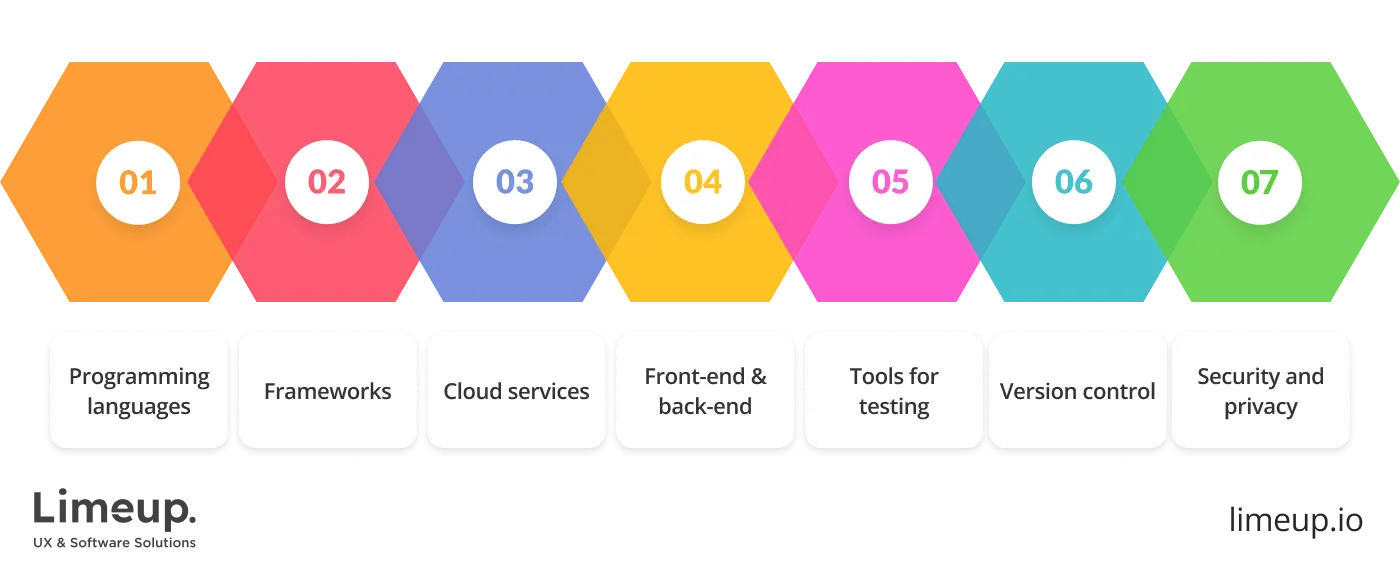
- Programming languages
Сoding instruments are the starting point for any victorious artificial intelligence app development. Рython dominates the landscape due to its efficiency and adaptability. Python leads the way thanks to its efficiency and adaptability, while R is excellent for statistical analysis. When performance matters, Java or C++ become the languages of choice. Еach one plays its part — just make sure it’s in the right scene.
- Frameworks
TensorFlow gets things moving fast and PyTorch keeps things flexible, making them top picks for any AI toolbox. Scikit-learn still holds its ground for classic ML jobs and Hugging Face Transformers is the rising star in language models. These aren’t just frameworks as they’re what keep deadlines intact and projects moving in the right direction.
- Cloud services
Unless you’re considering the monumental task of setting up your own data centers (hint: you’re probably not), the big cloud providers(AWS, Google Cloud, Azure) are the go-to for the heavy lifting. Their infrastructure is scalable, and with AI-specific utilities built-in, the process becomes faster and more efficient. Industry reports suggest that by 2034, AI-as-a-service could hit $178.7 bn globally, an upward trend powered by cloud-first adoption.
- Front-end and back-end
Even the smartest AI won’t shine if consumers can’t interact with it easily. React, Vue, Angular handle the front-end like pros. For the back-end, Node.js, Django, or Flask are solid bets. Together, they help translate brainy models into apps people actually want to use, not just stare at in confusion. This is a key factor when learning how to build an AI application — aligning all tech components to create smooth, responsive interactions and peak performance.
- Tools for testing and monitoring
Once the app’s live, it needs babysitting, no shame in that. MLOps tech like MLflow, Kubeflow, or even basic CI/CD pipelines make sure everything keeps running smoothly. Model drift, bugs, slow responses? Catch them before your audience does.
- Version control
Ever launched an update that broke everything? Git’s got your back. Whether it’s GitHub, GitLab, or Bitbucket, version control is like your app’s time machine. Made a mistake? Roll it back. Testing a new feature? Branch it out. It’s the kind of safety net you don’t appreciate until you’re dangling off the tightrope.
- Security and privacy
AI apps often chew on sensitive data: user behavior, conversations, health records, financials. If you’re not locking that down like Fort Knox when you are creating an AI app, you’re inviting trouble. Encrypt data in transit and at rest, stay GDPR/CCPA-compliant and use role-based access like a pro. Systems like Vault by HashiCorp or AWS Key Management Service (KMS) are able to help. Better safe than subpoenaed.
Not sure how to kick things off? Hire an AI developer who’s done this dance before. Their insight tends to keep you from walking into common traps and help chart a clear course forward.
How much does artificial intelligence app development cost?
Budgeting for an AI app may feel like booking a global trip. Some routes are fast and expensive, others are longer but easier on the wallet. It all depends on the journey you want: quick MVP or full enterprise-grade product.
The price tag of building an AI app changes depending on the app’s purpose, moving parts and the intelligence level involved. A lightweight chatbot might sit in the $30,000–$50,000 range. Something more powerful? Think north of $150,000.
Brief overview of what generic expenses look like:
| Factor | Impact on price | Estimated range |
| Аpp functionality | The combination of sophisticated features within the system results in increased dev time and prolonged testing requirements. | $30,000 – $300,000+ |
| Machine learning model | Higher levels of complexity demand increased programming hours and system optimization time along with greater resource. | $15,000 – $100,000 |
| Data preparation | All phases of data cleaning together with label assignment followed by data processing lead to longer execution schedule and increased expenses. | $10,000 – $50,000 |
| Third-party integration | The use of external systems requires organization to commit money and resolve system compatibility issues. | $5,000 – $30,000 |
| UI/UX design | Creating well-fitted intuitive designs demands the employment of specialists with professional experience. | $5,000 – $25,000 |
| Оngoing maintenance | The continuous maintenance of your app also includes periodic updates, bug fixes and server expenses to ensure proper operation. | $2,000 – $10,000/month |
А large chunk of your investment will go toward building a capable squad for AI-based app development. Hiring the best minds in the field might feel like a splurge, until you see what they build. Even after launch, your app won’t run itself. It needs regular updates, model improvements and fresh data. Set aside a chunk of the budget for long-term care, not just the initial build.
Besides, from what we’ve seen, location may swing the rates more than you’d expect. In the US or UK, expect hourly rates from $100 to $200+. Rates in Eastern Europe typically land between $40 and $70 per hour, while teams in South Asia often come in lower, ranging from $20 to $45. The price tag might differ, but that often reflects factors like work rhythm, time zone alignment and communication habits, not necessarily the quality of the code.
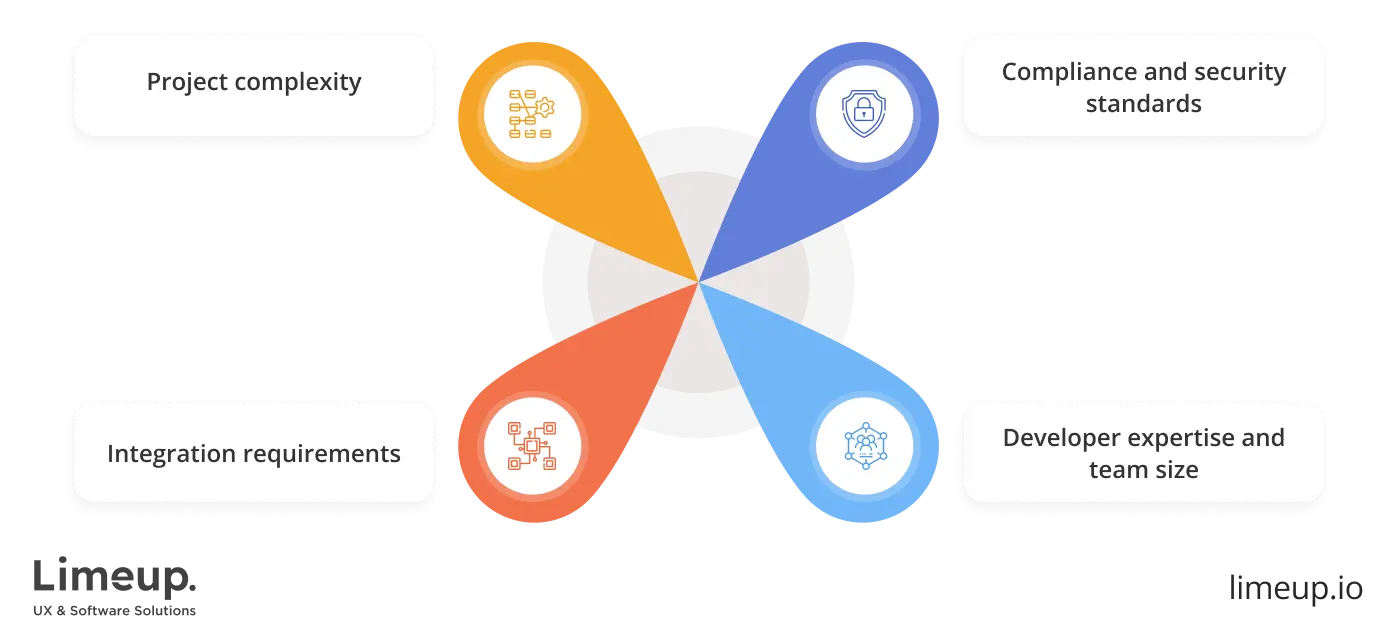
And be mindful of the clock as every extra week adds weight to the final invoice. AI apps often need iterative engineering and testing cycles, so working with a team that builds in agile sprints (rather than one giant leap) offers better odds of meeting goals and avoiding cost overruns.
Artificial intelligence mobile app development may not come cheap, but they tend to earn their keep. They remove the clutter of manual processes, strengthen customer connections and offer insights that guide success. And here’s the kicker: Gartner says by 2026, 80% of businesses will be using AI to boost performance.
If the fees breakdown feels like alphabet soup, app developers for hire know how to stretch your budget without cutting corners. A sharp partner helps you zoom in on key features, blocks rabbit holes and sets the pace from the start.
How to select a provider for building AI applications?
Picking the right one amidst AI software development firms is a bit like hiring a pit crew for a Formula 1 race — your idea might have horsepower, but without a capable workforce in the garage, you won’t get far off the starting line.
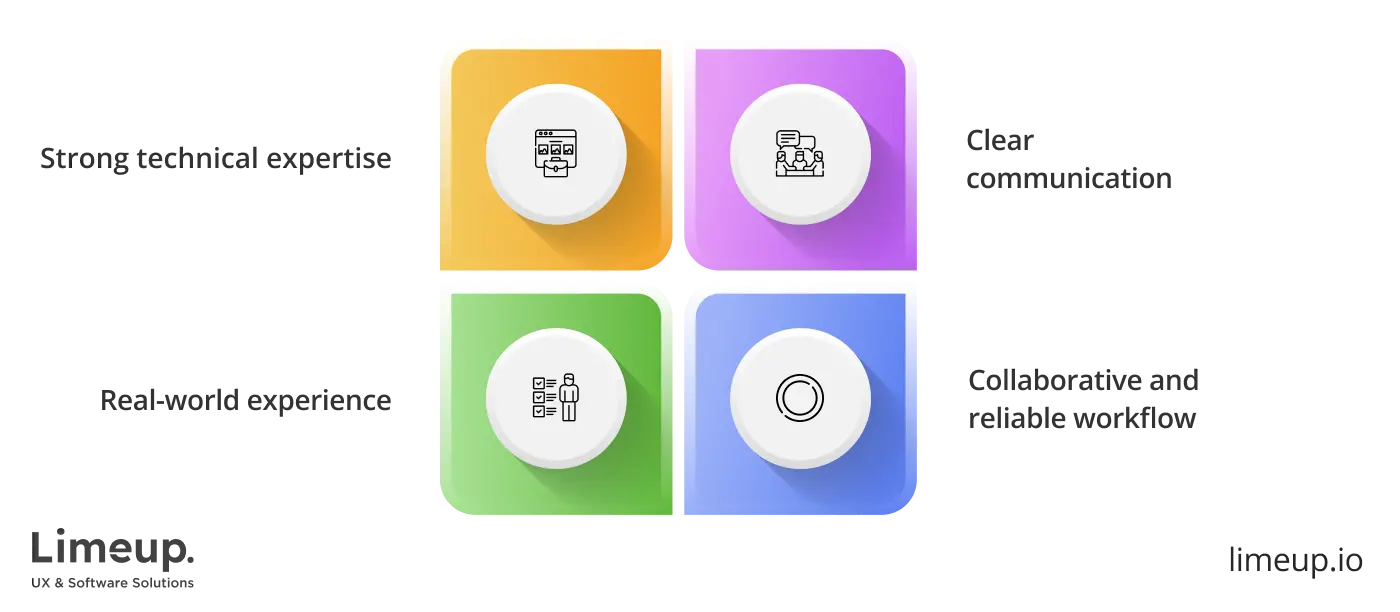
First things first, look under the hood. An AI app development company’s sleek portfolio with examples of relevant work is nice, but you want proof they’ve built more than just prototypes or flashy demos. Look for real-world products, ones that are out in the wild and still running. Ask questions like: What kind of AI did you build? What business goals did it hit? Who’s still using it? You want stories, not just specs.
Next, watch out for those who promise the moon but can’t explain how they’ll build the rocket. Beware if a provider starts speaking in circles or leans too heavily on technical buzzwords. Great developers explain the hard stuff simply, like they’re discussing it over a coffee, not giving a formal presentation. Straightforward communication today means fewer hiccups tomorrow.
Check out their resources. A proven team won’t just say they are able to handle your needs, they’ll show their way around tools like TensorFlow, PyTorch, and Scikit-learn. Bonus points if they’ve dabbled in the tech stack we outlined above еspecially if you’re looking to break new ground. The real question is how to develop AI applications that stand out and that take a comprehensive grasp of the latest software ecosystem.
It also pays to review how they roll. Do they create an AI application fast and iterate, or go heads-down for months and emerge with a mystery box? The former is usually better in the AI world, where training, testing and refining are part of the dance.
And speaking of dance, how well do they move with your team? A good partner is more than a vendor; they’re a partner who’s in sync with your pace, goals, way of working. If they disappear between milestones or ghost you after one call, that’s your cue to move on.
In the end, trust your gut, but back it up with homework. Ask for references. Dig into testimonials. Jump on a call with a project manager and a lead dev. A solid team doesn’t disappear after launch as they stick around to keep the gears turning.
Why build your AI app with Limeup?
Ideas are easy. Turning them into apps that think on their feet? That’s where the real craft kicks in. As you learned from our synopsis, smart software can spot fraud, recommend your next favorite movie, or guide patients toward early diagnosis, all before your morning coffee. No production reaches the finish line without a clear roadmap, the right stack and a crew that knows how to develop an AI application under pressure.
Every great product starts with solid code, dependable frameworks, setup that grows with your business. From design to deployment, every detail matters. It all has to work together like clockwork, even if the surface feels effortless.
Got an idea you believe in? Limeup brings the experience, the structure and the speed to get it out the door. Get in touch and let’s get it done.

